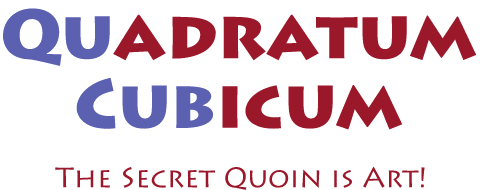
Liu Hui
 C. Cullen (2002). Learning from Liu Hui? A different way to do mathematics, Notices Amer. Math. Soc. 49, 783-790. C. Cullen (2002). Learning from Liu Hui? A different way to do mathematics, Notices Amer. Math. Soc. 49, 783-790.


 Karine Chemla (2005). Geometrical Figures and Generality in Ancient China and Beyond, Liu Hui and Zhao Shuang, Plato and Thabit ibn Qurra. Science in Context, 18, pp. 123-166. Karine Chemla (2005). Geometrical Figures and Generality in Ancient China and Beyond, Liu Hui and Zhao Shuang, Plato and Thabit ibn Qurra. Science in Context, 18, pp. 123-166.
Thabit ibn Qurra
 Thabit ibn Qurra (9th century). Risala fi'l-hujja al-mansuba ila Suqrat fi'l-murabba wa qutrihi (Treatise on the Proof Attributed so Socrates on the Square and Its Diagonals). Thabit ibn Qurra (9th century). Risala fi'l-hujja al-mansuba ila Suqrat fi'l-murabba wa qutrihi (Treatise on the Proof Attributed so Socrates on the Square and Its Diagonals).
 Sayili, Aydin (1960). Thabit Ibn Qurra's generalisation of the Pythagorean theorem. Isis 51, pp. 35-37. Sayili, Aydin (1960). Thabit Ibn Qurra's generalisation of the Pythagorean theorem. Isis 51, pp. 35-37.
Abu'l-Wafa'   
 Abu'l-Wafa' al-Buzajani (10th century). Kitab fima Yahtaju Ilayhi al-Sani' min A'mal al-Handasa (On the Geometric Constructions Necessary for the Artisan). Mashdad: Imama Riza 37, copied in the late 10th or the early 11th century. Persian manuscript. Bibliotheque Nationale de Paris. Abu'l-Wafa' al-Buzajani (10th century). Kitab fima Yahtaju Ilayhi al-Sani' min A'mal al-Handasa (On the Geometric Constructions Necessary for the Artisan). Mashdad: Imama Riza 37, copied in the late 10th or the early 11th century. Persian manuscript. Bibliotheque Nationale de Paris.
 Reza Sarhangi, Slavik Jablan (2006). Elementary Constructions of Persian Mosaics. Towson University and The Mathematical Institute. Reza Sarhangi, Slavik Jablan (2006). Elementary Constructions of Persian Mosaics. Towson University and The Mathematical Institute.

 Alpay Özdural (1995). Omar Khayyam, Mathematicians, and conversazioni with Artisans. Journal of the Society of Architectural Historians, Vol. 54, No. 1, pp. 54-71. Alpay Özdural (1995). Omar Khayyam, Mathematicians, and conversazioni with Artisans. Journal of the Society of Architectural Historians, Vol. 54, No. 1, pp. 54-71.

Bhaskara Acharya II
 Bhaskara Acharya II (1150). Lilavati. Algebra, with Arithmetic and Mensuration from the Sanscrit of Brahmegupta and Bháscara, English translation by Henry Thomas Colebrooke (1817). London: John Murray. Bhaskara Acharya II (1150). Lilavati. Algebra, with Arithmetic and Mensuration from the Sanscrit of Brahmegupta and Bháscara, English translation by Henry Thomas Colebrooke (1817). London: John Murray.
 Bibhutibhusan Datta & Avadhesh Narayan Singh. History of Hindu Mathematics. Combined edition of Parts I (1935) and II (1938). Bombay: Asia Publishing House, 1962. Bibhutibhusan Datta & Avadhesh Narayan Singh. History of Hindu Mathematics. Combined edition of Parts I (1935) and II (1938). Bombay: Asia Publishing House, 1962.

Abu Bakr al-Khalil al-Tajir al-Rasadi
 Alpay Özdural (2000). Mathematics and Arts: Connections between Theory and Practice in the Medieval Islamic World. Historia Mathematica, Volume 27, Issue 2, pp. 171-201. Alpay Özdural (2000). Mathematics and Arts: Connections between Theory and Practice in the Medieval Islamic World. Historia Mathematica, Volume 27, Issue 2, pp. 171-201.

 Alpay Özdural (1996). On Interlocking Similar or Corresponding Figures and Ornamental Patterns of Cubic Equations. Muqarnas vol. 13, pp. 191-211. Alpay Özdural (1996). On Interlocking Similar or Corresponding Figures and Ornamental Patterns of Cubic Equations. Muqarnas vol. 13, pp. 191-211.
 Alpay Özdural (1998). A Mathematical Sonata for Architecture: Omar Khayyam and the Friday Mosque of Isfahan. Technology and Culture vol. 39, pp. 699-715. Alpay Özdural (1998). A Mathematical Sonata for Architecture: Omar Khayyam and the Friday Mosque of Isfahan. Technology and Culture vol. 39, pp. 699-715.
 Alpay Özdural (2002). The Use of Cubic Equations in Islamic Art and Architecture, in Nexus IV: Architecture and Mathematics, edited by José Francisco Rodrigues and Kim Williams. Turin, Italy: Kim Williams Books. Alpay Özdural (2002). The Use of Cubic Equations in Islamic Art and Architecture, in Nexus IV: Architecture and Mathematics, edited by José Francisco Rodrigues and Kim Williams. Turin, Italy: Kim Williams Books.
Jean-Étienne Montucla
 Jean-Étienne Montucla (1778). Re-edited Jacques Ozanam (1640-1717) Récréations mathématiques, Tome 1 (1694), p. 297 Pl.15. Jean-Étienne Montucla (1778). Re-edited Jacques Ozanam (1640-1717) Récréations mathématiques, Tome 1 (1694), p. 297 Pl.15.
 Emile Fourrey (1910). Curiosités Géométriques pp. 117-125. Emile Fourrey (1910). Curiosités Géométriques pp. 117-125. 
Philip Kelland
 Philip Kelland (1855). On superposition. Transactions of the Royal Society of Edinburgh 21, 271-3 and plate V. Philip Kelland (1855). On superposition. Transactions of the Royal Society of Edinburgh 21, 271-3 and plate V.

 Philip Kelland's solution (1882). Knowledge: a monthly record of science. Vol.1 (13 Jan p.229 item 184, 3 mars p.380), Wyman and sons. Philip Kelland's solution (1882). Knowledge: a monthly record of science. Vol.1 (13 Jan p.229 item 184, 3 mars p.380), Wyman and sons. 
Paul Busschop
 Paul Busschop (1873). Reproduced in Catalan Géométrie Elémentaire, 5th ed. Paris: Dunod. See p. 194. Paul Busschop (1873). Reproduced in Catalan Géométrie Elémentaire, 5th ed. Paris: Dunod. See p. 194.
 Paul Busschop (1875). Problème de Géométrie. Nouvelle Correspondance Mathématiques. Vol ii, p. 83. Paul Busschop (1875). Problème de Géométrie. Nouvelle Correspondance Mathématiques. Vol ii, p. 83.
Colonnel de Coatpont
 M. De Coatpont, colonnel du Génie à Rennes (1877). Sur un problème de M. Busschop. Nouvelle Correspondance Mathématique 3, 116-17. M. De Coatpont, colonnel du Génie à Rennes (1877). Sur un problème de M. Busschop. Nouvelle Correspondance Mathématique 3, 116-17.
 Walter William Rouse Ball (1892). Mathematical Recreations and Essays. p. 258. Walter William Rouse Ball (1892). Mathematical Recreations and Essays. p. 258.

Edouard Lucas
 Lucas, Edouard (1883). Récréations Mathématiques, Volume 2. Paris: Gauthier-Villars. Second of four volumes. Second edition (1893) reprinted by Blanchard in 1960. See pp.151 and 152 in Volume 2 of this edition. Available online (pp. 145-147). Lucas, Edouard (1883). Récréations Mathématiques, Volume 2. Paris: Gauthier-Villars. Second of four volumes. Second edition (1893) reprinted by Blanchard in 1960. See pp.151 and 152 in Volume 2 of this edition. Available online (pp. 145-147).

Henry Perigal
 Henry Perigal (1875). On Geometric Dissections and Transformations, in the Messenger of Mathematics, No. 19, 1875. Henry Perigal (1875). On Geometric Dissections and Transformations, in the Messenger of Mathematics, No. 19, 1875.

 Henry Perigal (1891). Geometric Dissections and Transpositions. London: Bell & Sons. Association for the Improvement of Geometrical Teaching, later renamed Mathematical Association. Henry Perigal (1891). Geometric Dissections and Transpositions. London: Bell & Sons. Association for the Improvement of Geometrical Teaching, later renamed Mathematical Association.

 L. J. Rogers (1897). Biography of Henry Perigal in appendix of On certain Regular Polygons in Modular Network. Proceedings London Mathematical Society. Volume s1-29, pp. 732-735. L. J. Rogers (1897). Biography of Henry Perigal in appendix of On certain Regular Polygons in Modular Network. Proceedings London Mathematical Society. Volume s1-29, pp. 732-735.

 Online biography by Bill Casselman. Online biography by Bill Casselman.  
Henry Ernest Dudeney
 Henry Ernest Dudeney (April 8, 1900). Puzzles and prizes. The Three Squares Puzzles, Column in Dispatch. Henry Ernest Dudeney (April 8, 1900). Puzzles and prizes. The Three Squares Puzzles, Column in Dispatch.
 Henry Ernest Dudeney dit le "Sphinx" (1908). The Canterbury Puzzles and other curious problems. New York: E. P. Dutton and Co. Henry Ernest Dudeney dit le "Sphinx" (1908). The Canterbury Puzzles and other curious problems. New York: E. P. Dutton and Co.

Sam Loyd's
 Sam Loyd's (1914). Cyclopedia of 5,000 Puzzles. The three napkins: dissect square into three [T3] GL1.58. Tricks and Conundrums ed. by Sam Loyd Jr. Reprint of Loyd's Our Puzzle Magazine, a quarterly which started in June 1907 and ran till 1908. Lamb Publishing, 1914. Sam Loyd's (1914). Cyclopedia of 5,000 Puzzles. The three napkins: dissect square into three [T3] GL1.58. Tricks and Conundrums ed. by Sam Loyd Jr. Reprint of Loyd's Our Puzzle Magazine, a quarterly which started in June 1907 and ran till 1908. Lamb Publishing, 1914.

David Singmaster
 David Singmaster (1995). Sources in Recreational Mathematics: An Annotated Bibliography. London: South Bank University. 7th preliminary edition. See Chapter 6.AS.3 of the online list. David Singmaster (1995). Sources in Recreational Mathematics: An Annotated Bibliography. London: South Bank University. 7th preliminary edition. See Chapter 6.AS.3 of the online list.


Maths journals
 Hypercube (2001) No 35 pp. 12-13. Hypercube (2001) No 35 pp. 12-13.
 Tangentes Mathématiques (2007) No 31 pp. 42-44. Tangentes Mathématiques (2007) No 31 pp. 42-44.
Nobuyuki Yoshigahara
 Yoshigahara, Nobuyuki (2004). Puzzles 101: a puzzlemaste's challenge. Three Times More. A.K. Peters, puzzle #8 p.6, two solutions p.70. Yoshigahara, Nobuyuki (2004). Puzzles 101: a puzzlemaste's challenge. Three Times More. A.K. Peters, puzzle #8 p.6, two solutions p.70.


Greg N. Frederickson     
 Frederickson, Greg (1997) Dissections: Plane & Fancy. Cambridge University Press. Frederickson, Greg (1997) Dissections: Plane & Fancy. Cambridge University Press.

 Frederickson, Greg (2002) Hinged Dissections: Swinging & Twisting. Cambridge University Press. Frederickson, Greg (2002) Hinged Dissections: Swinging & Twisting. Cambridge University Press.

 Frederickson, Greg (2006) Piano-hinged Dissections: Time to Fold!. A K Peters Ltd. Frederickson, Greg (2006) Piano-hinged Dissections: Time to Fold!. A K Peters Ltd.

|

